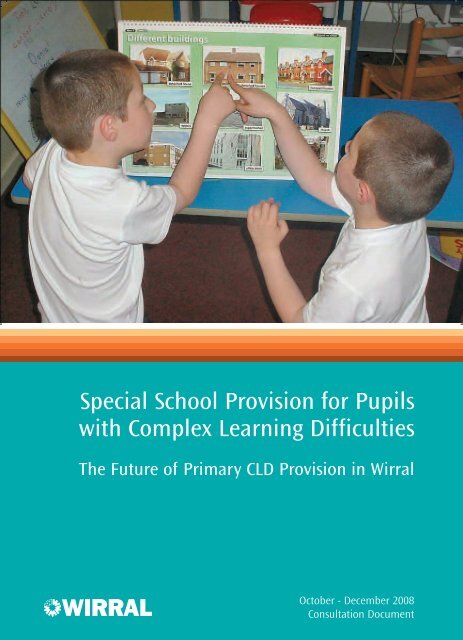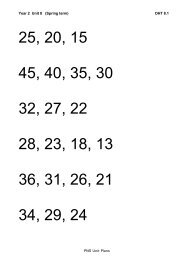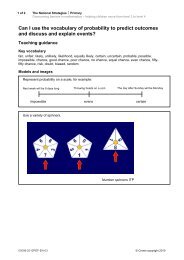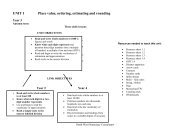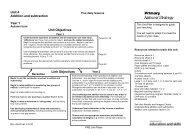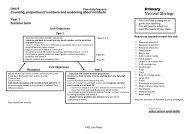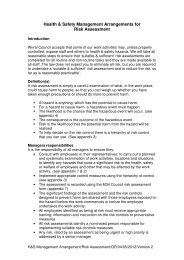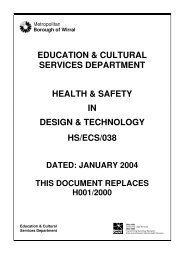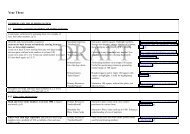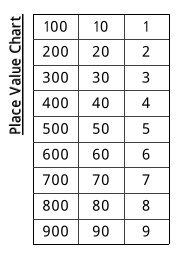full Consultation document - Wirral Learning Grid
full Consultation document - Wirral Learning Grid
full Consultation document - Wirral Learning Grid
You also want an ePaper? Increase the reach of your titles
YUMPU automatically turns print PDFs into web optimized ePapers that Google loves.
Special School Provision for Pupils<br />
with Complex <strong>Learning</strong> Difficulties<br />
The Future of Primary CLD Provision in <strong>Wirral</strong><br />
October - December 2008<br />
<strong>Consultation</strong> Document
CONSULTATION DOCUMENT<br />
SPECIAL SCHOOL PROVISION FOR PUPILS WITH COMPLEX<br />
LEARNING DIFFICULTIES<br />
THE FUTURE OF PRIMARY CLD PROVISION IN WIRRAL<br />
CONTENTS<br />
Introduction 2<br />
What has happened so far 2<br />
What happens now 2<br />
Current Provision 3<br />
Areas for improvement 3<br />
Why consider change 4<br />
Options for change<br />
Option 1 - Creating three newly built generic primary CLD schools 6<br />
each co-located with a mainstream primary school<br />
Option 2 - Creating two newly built 100 place generic primary CLD 7<br />
schools, each co-located with a mainstream primary school<br />
Option 3 - Creating a single new 200 place generic primary CLD 8<br />
school, co-located with a mainstream primary school<br />
Option 4 - Creating a single 2-19 school for pupils with profound 8<br />
and multiple learning difficulties<br />
The <strong>Consultation</strong> 10<br />
Finding out more 11<br />
What happens next 12<br />
Have your say – Making a Response 14<br />
Pages<br />
<strong>Consultation</strong> Feedback Form 15-16
Introduction<br />
The Local Authority has three primary special schools for pupils with CLD.<br />
Elleray Park School, Stanley School and The Lyndale School all meet the needs of pupils<br />
aged 2-11. Following initial work undertaken by the special school headteachers and<br />
discussions with stakeholders within each of the three schools the Authority have been asked<br />
to undertake a comprehensive review of current provision and to produce a plan for the future<br />
development of <strong>Wirral</strong>’s special schools<br />
What has happened so far<br />
Meetings have been held with headteachers, staff, governors, parents and pupils at all three<br />
schools to gather views on current provision and how it could be enhanced. Consideration was<br />
given to the needs of this group of young people and their families over the next ten years and<br />
into the future, and the anticipated demands that will be placed upon <strong>Wirral</strong>’s special school<br />
provision. A dialogue has also begun with partners in the Health Authority to consider how<br />
educational, social care and health provision for young people could be more effectively<br />
integrated.<br />
The <strong>Wirral</strong> special school headteachers group have worked together to consider all of the<br />
different types of special school provision in <strong>Wirral</strong>, and have set out their view on how this<br />
could be developed and improved in the future. The headteachers began by considering the<br />
present and future provision needed locally for secondary age pupils with CLD, then extending<br />
their considerations to primary provision.<br />
Taking into consideration the quality of the current provision, including the standards of<br />
teaching and learning, the accommodation, facilities and the opportunities available to the<br />
pupils and their families, there was general agreement that while the present standard of<br />
provision is very good it could be improved further if some reorganisation and changes in<br />
accommodation were made.<br />
What happens now<br />
The Local Authority is consulting you on the following options:<br />
Option 1<br />
Option 2<br />
Rebuild all three existing schools as generic primary CLD schools,<br />
each one co-located with a mainstream primary school<br />
Replace the three existing schools with two newly built 100 place<br />
generic primary CLD schools, each co-located with a mainstream<br />
primary school<br />
Option 3<br />
Option 4<br />
Replace the three existing schools with a single new 200 place generic<br />
primary CLD school, co-located with a mainstream primary school.<br />
Create a single 2 to 19 school for pupils with profound and multiple<br />
learning difficulties<br />
2
Current Provision<br />
Number on roll<br />
Elleray Park School, Stanley School and The Lyndale School provide for a combined current<br />
population of 208 pupils - Elleray Park School currently has 83 pupils, Stanley School has 91<br />
pupils and The Lyndale School has 34 pupils. This includes a small number of part time places<br />
for very young pupils in nursery classes.<br />
The numbers in the three primary schools have fluctuated over the years. At present numbers<br />
in The Lyndale School have reduced while Elleray Park has seen a recent growth in numbers.<br />
Stanley School’s numbers have been more stable for many years. Factors such as a change<br />
of key staff in the school, new and improved facilities or developments in teaching and<br />
learning can all influence parental preference.<br />
In spring 2008 Council agreed with the proposal to change the number of funded places at<br />
Elleray Park School and The Lyndale School. There was an increase in the number of funded<br />
places at Elleray Park to 75, and a reduction in the number of funded places for pupils with<br />
social and communication difficulties at The Lyndale School from 55 to 45 over a two year<br />
period.<br />
Standards<br />
Stanley School and The Lyndale School were both inspected in 2007. Elleray Park School<br />
was inspected in 2008. All three schools were judged to make outstanding provision.<br />
Range of needs<br />
Within the existing primary CLD schools in <strong>Wirral</strong> there are a wide range of pupils including<br />
those with severe learning difficulties, autism, physical disabilities and profound and multiple<br />
learning difficulties. While each school is designated as a generic CLD special school, custom<br />
and practice has resulted in individual schools taking more pupils with a particular type of<br />
need.<br />
Accommodation<br />
The accommodation available at the three primary schools has a number of limitations.<br />
Stanley School shares a site with Thingwall Primary School and close links are maintained<br />
between both schools, much to the benefit of the pupils. Stanley School does not however<br />
meet current accessibility requirements and pupils who are wheelchair users cannot be placed<br />
at the school.<br />
Elleray Park School has many accommodation restrictions, particularly given the recent rapid<br />
rise in the number of pupils on roll. The building does not <strong>full</strong>y allow for effective delivery of<br />
much of the therapeutic provision that is required within the pupil’s timetables.<br />
The Lyndale School opened in 1999 and is within a refurbished building. Its facilities are<br />
attractive and modern but its limited number of classrooms restricts the number and range of<br />
pupils it can accommodate. Elleray Park School and The Lyndale School are not co-located<br />
alongside a mainstream primary school.<br />
Areas for Improvement<br />
A number of parents attended the initial discussion meetings in each of the schools. All of<br />
those parents present were very positive about their child’s current school and the education<br />
and care that was provided. Given the high standard of current practice within all three CLD<br />
schools there is agreement that any changes that were made to local provision must build on<br />
existing standards and bring clear benefits for pupils and their families.<br />
3
Extended school provision<br />
The development of extended schools provision for pupils with complex learning difficulties,<br />
including wrap around child care and school holiday activities is a priority for future<br />
development. This was a major feature in comments from parents, many of whom indicate<br />
that a lack of accessible, appropriate and affordable child care that meets the special needs of<br />
their child prevents them from seeking or maintaining employment. Better year round access<br />
to health professionals and integrated provision from education, social care and health<br />
professionals in one location was another priority for future development amongst all parents.<br />
An important part of this consultation on the future of schools for pupils with CLD is the<br />
dialogue that is taking place with between officers within the Children and Young People’s<br />
Department and staff working in the health sector from both the Primary Care Trust and <strong>Wirral</strong><br />
Hospital NHS Trust. There is a strong commitment from everyone concerned to explore the<br />
opportunities for improving services for this group of young people and their families, and to<br />
consider any possibilities for co-locating services in a ways that can improve them and make<br />
them more accessible for the users.<br />
Meeting the wide ranging needs of pupils<br />
The practical issue of combining groups of pupils with a range of needs was explored in many<br />
of the initial discussions. If local provision were to change in the future parents, staff and<br />
governors want reassurance that the cohorts of pupils across the complex learning difficulties<br />
continuum could continue to have their education, health and care needs met appropriately in<br />
a safe environment. A small number of parents also voiced concern over a potential loss of<br />
choice of schools if there was to be any change in existing provision.<br />
Transition between primary and secondary provision<br />
Some parents argued that a 2 to 19 school on a single site would remove the need for pupils<br />
to transfer to a different setting when they reach 11 years old.<br />
Benefits of co-location<br />
There are inclusion opportunities currently available to pupils at Stanley School that are not<br />
available to pupils at Elleray Park School or The Lyndale School. Many parents, staff and<br />
governors supported a move to premises co-located with a mainstream primary school site.<br />
Why consider change<br />
All three existing schools have been judged by Ofsted as outstanding and it is understandable<br />
that changes might be seen as unsettling for pupils, parents, staff and governors who may<br />
worry about the impact on existing high standards. Without careful planning and preparation,<br />
any reorganisation of the existing primary CLD school provision could be unsettling for this<br />
group of young people, a number of whom find any changes a cause of stress and anxiety.<br />
This being said the pupils within the CLD sector often face and cope with a variety of changes<br />
throughout their school lives. Moving between classes as the child gets older, a change of<br />
staff within the class or the transfer to another school without careful preparation and support<br />
would all be potentially difficult times for the children. The staff within <strong>Wirral</strong>’s special schools<br />
do their best to help pupils to progress and face such changes. If there were to be any major<br />
alterations in the number, nature or location of the CLD schools in the future then these staff<br />
would once again work to support the pupils and their families to cope with such changes in a<br />
positive way.<br />
Some parents have previously expressed concern about the combinations of pupils within a<br />
more generic CLD school and the vulnerability of some pupils. Parents in all three schools<br />
4
worry about any change in current school provision that resulted in more vulnerable pupils<br />
being placed alongside those pupils with more challenging behaviours.<br />
The existing three schools offer a choice of size and location of school. In some aspects they<br />
also differ in their population and the approach that the school adopts to class grouping and<br />
the delivery of the timetable. Any change in the range of provision in <strong>Wirral</strong> would reduce this<br />
choice for parents and pupils.<br />
However, the standard and suitability of the accommodation within the three existing primary<br />
CLD schools is variable and could be improved through the creation of new accommodation<br />
and facilities. Stanley School cannot offer suitable provision for pupils who are wheelchair<br />
users because of problems with space and accessibility within the building. Any new schools<br />
buildings would have to meet current accessibility requirements.<br />
Stanley School shares a site with Thingwall Primary School and close links are maintained<br />
between both schools, much to the benefit of the pupils. Elleray Park School and The Lyndale<br />
School are not co-located alongside a mainstream primary school and so their pupils cannot<br />
participate in inclusive activities with mainstream pupils as easily or to the same extent as<br />
pupils at Stanley School. Co-locating all CLD school provision in future would address this<br />
current inequality of opportunity.<br />
The building at Ellery Park has undergone a number of changes and improvements over<br />
recent years but is still restricted in terms of space and facilities. The Lyndale School building<br />
is reasonably well appointed but has limited space so has restrictions in the range and size of<br />
provision they can offer.<br />
The present accommodation and facilities on all three site offers limited opportunities for<br />
extended school provision including before and after school child care, holiday activities and<br />
access to health and therapy staff during the school holidays.<br />
Examples of new special schools recently built in other authorities clearly demonstrate what is<br />
needed in a modern, fit for purpose special school. Bright, attractive learning environments;<br />
good pupil personal care facilities; storage areas for all of the equipment used by pupils and<br />
staff; suitable transport and parking areas are all features of modern special schools but<br />
cannot be found in many of <strong>Wirral</strong>’s special schools.<br />
<strong>Wirral</strong> is likely to receive substantial new Government funding in the coming years, under the<br />
Building Schools for the Future and Primary Capital programme. This will provide a major<br />
opportunity to build new schools in <strong>Wirral</strong> or to remodel and modernise existing buildings. It is<br />
important that the needs of the special school sector and the pupils within it are included within<br />
these programmes. Planning any changes to special school provision is not a quick or simple<br />
exercise, and careful consideration must be given to the opportunities that any such<br />
investment of additional funding can offer.<br />
The small size of schools is also a factor. If the numbers in a school fall too far, there will be<br />
fewer teachers, so each teacher has to be responsible for two or more subjects, as well as<br />
their usual workload. Very small schools find it more difficult to offer the depth and breadth of<br />
subjects expected by Ofsted, which all pupils are entitled to, whether in mainstream or special<br />
schools.<br />
5
Options for Change<br />
Option 1- Creating three newly built generic primary CLD schools, each co-located<br />
with a mainstream primary school<br />
How would provision be improved<br />
This option maintains the current degree of choice between three schools.<br />
Elleray Park could move to new co-located premises alongside a mainstream primary school<br />
giving pupils the opportunity to participate in inclusive activities with mainstream pupils. The<br />
school could extend the range of inclusive educational opportunities for its population. Elleray<br />
Park, along with the other primary CLD schools could look for opportunities to open CLD<br />
resource bases within the primary mainstream sector.<br />
Building a new school of a similar size on the same site adjacent to Thingwall Primary School<br />
would enable Stanley School to continue and develop its present inclusion links between the<br />
two schools, including the possibility of joint Foundation 2 (nursery) provision.<br />
Lyndale School could move to new co-located premises alongside a mainstream primary<br />
school giving pupils the opportunity to participate in inclusive activities with mainstream pupils.<br />
Provision for pupils of average ability that have complex medical needs could be provided<br />
between the new special school and its co-located mainstream primary school.<br />
All three schools would include accommodation and facilities on each site offering extended<br />
school provision, including before and after school child care, holiday activities and access to<br />
health and therapy staff during the school holidays. Additional consideration could be given to<br />
providing facilities for short breaks for families on site.<br />
Factors to consider<br />
There are approximately 200 primary aged pupils with CLD at any time, and this seems to<br />
remain fairly constant. Maintaining three separate schools would mean that any fluctuation in<br />
the number on roll in an individual school would continue to cause that school practical and<br />
financial difficulties.<br />
This issue could be solved by creating three schools of a similar size, but this would result in a<br />
reduction in the size of two of the existing schools which could be unpopular with parents and<br />
the schools concerned.<br />
If the Council wanted maintain a choice between three primary CLD schools at the same size<br />
as they are now, and to co-locate each school in the future, the Council would have to commit<br />
to rebuilding schools of different sizes, one of which would continue to offer less than 50<br />
primary places.<br />
Building three new schools would be extremely expensive and potentially beyond the scope of<br />
the available funding. Building fewer, larger school buildings is likely to be more cost effective.<br />
6
Option 2- Creating two newly built 100 place generic primary CLD schools, each colocated<br />
with a mainstream primary school<br />
How would provision be improved<br />
Each of the two schools could provide 100 places and could offer a range of integrated<br />
extended school provision including before and after school child care, holiday activities and<br />
access to health and therapy staff during the school holidays.<br />
Both schools would be co-located alongside a mainstream primary school.<br />
Two schools could continue to offer parents a choice between special schools, and could be<br />
situated within different parts of the borough<br />
Both schools would provide for the <strong>full</strong> range of needs of pupils within the CLD and PMLD<br />
continuum.<br />
Both schools would make provision for outreach and in-reach to support pupils within<br />
mainstream provision<br />
Building two new primary CLD schools, each offering 100 places would be more cost effective<br />
than rebuilding three separate schools.<br />
Identifying suitable locations for two 100 place special schools that are co-located with<br />
mainstream primary schools may be easier than it would be for the three school option.]<br />
Both primary CLD schools could look for opportunities to open CLD resource bases within the<br />
primary mainstream schools. This would offer another choice of provision for parents who do<br />
not want a <strong>full</strong>-time special school place, but where the child needs some specialist provision<br />
that could not be offered solely within a mainstream classroom. Any bases that were<br />
established could be lead by the CLD school, and could also offer some of the special school’s<br />
pupils an additional opportunity to spend some time working within a mainstream school<br />
environment.<br />
Factors to consider<br />
In this option, at least one existing school would close, or two schools could be amalgamated.<br />
For pupils and staff at The Lyndale School the prospect of being part of a 100 place school<br />
may appear to be a major contrast to the size of their current school. For pupils and staff at<br />
Elleray Park and Stanley the change would be less noticeable given the size of their present<br />
schools.<br />
Given the present sites of the three primary CLD schools, any new schools built in different<br />
locations could result in some pupils having a longer journey to school each day. This is not<br />
certain however. At present 14 pupils travel over 5 miles per day to reach the Lyndale School<br />
and 13 pupils have a similar length journey to reach Stanley School. Moving locations could<br />
potentially reduce or increase these numbers, as any new schools would continue to take<br />
pupils from across the borough.<br />
7
Option 3- Creating a single new 200 place generic primary CLD school, co-located<br />
with a mainstream primary school<br />
How would provision be improved<br />
Under this option, one new primary CLD school would provide 200 places for all of the young<br />
people with complex and profound learning difficulties in <strong>Wirral</strong>.<br />
As a single centre of excellence, the school could offer a range of integrated and extended<br />
school provision including before and after school child care, holiday activities and access to<br />
health and therapy staff during the school holidays.<br />
The single school would be co-located alongside a mainstream primary school, and the school<br />
would make provision for outreach and in-reach to support pupils within mainstream provision.<br />
The single school option would be less expensive than both the three and two school options.<br />
It may be easier to identify a suitable location for a 200 place special school co-located on a<br />
mainstream site than both the three and two school options.<br />
Factors to consider<br />
A single 200 place primary CLD school would offer parents no choice between special schools<br />
in <strong>Wirral</strong>.<br />
This option would require the closure of at least two of the existing three schools, or the<br />
amalgamation of all three schools<br />
A single 200 place primary CLD school may seem very large to pupils, parents and staff and<br />
substantially different in its size and nature to their current schools.<br />
The location of a single school may result in some pupils having longer journeys to school<br />
than they do at present, although this would depend upon the location of the provision and<br />
pupil’s home.<br />
Option 4- Creating a single 2-19 school for pupils with profound and multiple<br />
learning difficulties<br />
This option arose from initial discussions with a group of parents at The Lyndale School.<br />
There are currently 60 pupils with profound and multiple learning difficulties within 4 of the 5<br />
CLD schools. Elleray Park School, The Lyndale School, Foxfield School and Meadowside<br />
School all have a similar number of young people with these needs on roll.<br />
How would provision be improved<br />
A single PMLD school would provide a centre of expertise for meeting the education and care<br />
needs of this group of pupils and would remove the need for these pupils to transfer from a<br />
primary to secondary school setting when they reach 11 years old.<br />
A school for pupils with PMLD could reduce the risks associated with being within a more<br />
generic CLD school where very vulnerable children are in the same school building as pupils<br />
whose behaviour can be erratic, aggressive or unpredictable.<br />
Integrated provision for pupils with PMLD including education, health, and social care could be<br />
built into the planning and operation of a single specialist PMLD school.<br />
Factors to consider<br />
<strong>Wirral</strong> were one of the earlier Local Authorities to reorganise its special school provision into<br />
primary and secondary phases. Returning any special school in <strong>Wirral</strong> to 2-19 provision could<br />
be seen as a backwards step.<br />
The existing range of provision for pupils with PMLD allows parents to express a preference<br />
for a school or system of class grouping and curriculum delivery that they prefer and which<br />
8
they feel best meets their child’s needs. Having a single school for this group of pupils could<br />
remove this range of options and any possibilities for pupils learning and socialising in their<br />
classroom with other children with a broader range of needs. This is likely to be unpopular<br />
with some parents.<br />
While the pupils may participate in inclusive experiences within a collocated mainstream<br />
school they could not be a part of a ‘mixed ability’ CLD class and the pupil interaction<br />
opportunities that this offers.<br />
Creating a single school for pupils with PMLD would remove all choice of special school<br />
provision for this group of pupils through their entire school career.<br />
As this group of pupils grow older they may continue to have profound and complex difficulties<br />
but the transfer to secondary provision at aged 11 recognises their increased maturity. It<br />
confirms the expectation that they will be respected as adolescents, and that preparation and<br />
consideration will be given to their life as young adults beyond school.<br />
Any generic CLD school would seek to minimise the risks associated with having very<br />
vulnerable pupils in the same building as pupils whose behaviour can be erratic, aggressive or<br />
unpredictable. Identifying pupils with PMLD and those with challenging behaviours is not a<br />
precise science however, and at times the two can overlap. If a specialist PMLD school were<br />
created in <strong>Wirral</strong> where could the Authority place a pupil with such needs who then developed<br />
behaviours that were difficult to manage and presented a risk to other pupils<br />
There are a small but increasing number of vulnerable pupils who have complex medical<br />
needs that require specialist input and supervision but who do not specifically have PMLD.<br />
Many of these pupils have moderate or severe learning difficulties. It would therefore be<br />
inappropriate to place them in a PMLD setting that could not help them to reach their learning<br />
potential. More generic CLD provision that included integrated health services and support<br />
could provide the correct environment for meeting these children’s cognitive, physical and<br />
medical needs.<br />
9
The <strong>Consultation</strong><br />
We understand that amalgamating or closing any school is a difficult and sensitive issue for<br />
the whole community. Detailed community, transport and personnel matters will need to be<br />
considered before any option could be put into practice.<br />
It is important for you to understand that a decision has not already been made. The<br />
Council’s Cabinet will want to see the comments made during consultation before making<br />
any decision about what happens next.<br />
What the options would mean for children and young people<br />
The main concern would be to place the pupils in their new setting with as little disturbance<br />
to their education as possible.<br />
All the options would potentially involve existing pupils attending a new school or site to that<br />
which they are already attending. When schools are closed or amalgamated to form new<br />
schools, children who transfer to a different site to the one they already attend will move<br />
together with other students of the same age group. This has the advantage that young<br />
people move with their classmates and friends.<br />
Criteria for the entitlement to free Local Authority transport would not change, and as now,<br />
no pupil would be expected to travel more than an hour to school. Depending on the home<br />
address of individual pupils, it is possible that in some cases the escort would change, as<br />
pickup routes are adjusted to the new arrangements.<br />
What the option would mean for staff<br />
When a school is closed, all the staff are made redundant and are available for<br />
redeployment. As additional children would attend the remaining schools, it is likely that<br />
these schools would require additional staff, and it is up to the governing bodies of those<br />
schools to make appointments.<br />
When two or more schools amalgamate, all the schools close and then a new school opens.<br />
This means all the staff at all the schools are made redundant and can be redeployed. The<br />
new school will of course need staff, and it is up to the new governing body to make<br />
appointments.<br />
10
<strong>Wirral</strong> Council has an excellent record on redeployment both for teachers and other school<br />
staff.<br />
What the option would mean for school sites<br />
Amalgamation or opening new schools can be carried out in the existing buildings while<br />
decisions are made as to where and how many newly built schools will be made. This means<br />
that in the short-term, it is likely that no changes will be made to the sites that are in use as<br />
primary CLD schools.<br />
The longer term goal of the options for change is to build one or more new co-located schools<br />
with a mainstream school. This may result in existing school site(s) being no longer required<br />
for use as a school. The future of any site that was no longer required as a school would be<br />
determined by the Council. There are no plans or planning applications for any site at this<br />
stage.<br />
Finding out more<br />
If you want more information about the option, you can find out more on the Internet. Go to<br />
www.wirral-mbc.gov.uk/primaryplaces, and click on Special School Review. You will find:<br />
• The <strong>full</strong> <strong>Consultation</strong> <strong>document</strong><br />
• A Review pack of background information about Elleray Park, The Lyndale School and<br />
Stanley School<br />
• The Cabinet report and resolution<br />
• How to send your comments to the Director<br />
If you do not have access to the Internet at home, you can go to your local library where staff<br />
will help you log on and print out the information.<br />
The <strong>full</strong> <strong>Consultation</strong> <strong>document</strong> and the Review pack are also available for you to read at your<br />
school, and at the following places:<br />
Libraries<br />
Eastham<br />
Pensby<br />
Seacombe<br />
Birkenhead Central<br />
Wallasey Central<br />
Community Centres<br />
Delamere Community Centre<br />
Pensby Community Centre<br />
Liscard Community Centre<br />
You can also look at these <strong>document</strong>s at Wallasey Town Hall.<br />
11
If you want a printed copy, please contact the Asset Management Team, Hamilton Building,<br />
Conway Street, Birkenhead, CH41 4FD, 0151 666 4351, or by e-mail at<br />
specialreview@wirral.gov.uk.<br />
What happens next<br />
Step 1. The first step is to distribute the <strong>Consultation</strong> <strong>document</strong> and ask for views and<br />
comments.<br />
<strong>Consultation</strong> meetings<br />
There will be <strong>Consultation</strong> meetings at Stanley School, Elleray Park School and Lyndale<br />
School, as well as at the secondary CLD special schools. The meetings will start at 7 o’clock<br />
in the evening.<br />
Stanley on Tuesday, 18 th November 2008<br />
Elleray Park on Wednesday, 19 th November 2008<br />
Lyndale on Thursday, 20 th November 2008<br />
The meeting is an opportunity for parents, carers, staff, governors and other people directly<br />
related to the school to have their views heard and noted by senior staff from the Children and<br />
Young People’s Department and the Council’s Cabinet Member for Children’s Services and<br />
Lifelong <strong>Learning</strong>. On-site childcare facilities are available for these meetings, however places<br />
must be pre-booked through the school.<br />
A Drop-in session will also be held at Meadowside School on 25 th November 2008<br />
between 1-3pm and 5-7pm .<br />
The drop-in session is an opportunity for individuals or small groups of parents/carers, staff<br />
and governors to find out more information and speak personally to senior staff from the<br />
Children and Young People’s Department. To make an appointment to speak to someone<br />
at the Drop–in Session please telephone Meadowside School on 0151 678 7711.<br />
Writing in<br />
People associated with other mainstream and special schools, and members of the public who<br />
want to, can write in with their views. Anyone who wants to can write and say what they think.<br />
When the <strong>Consultation</strong> ends, all the views and opinions received in writing and at the<br />
consultation meetings will be combined into a report to the Council’s Cabinet. Cabinet<br />
members will read the report and decide what to do next. They may decide not to go further at<br />
12
this stage. Members might make changes to the options, consider other options put forward<br />
as part of the consultation, or they could decide to do more consultation.<br />
Step 2. If the Cabinet decides to go ahead with an option, it becomes a formal proposal.<br />
About competitions<br />
If the proposals require a new school to be established, under the Education and Inspections<br />
Act the Authority would usually be required to hold a competition to determine who will<br />
establish the new school.<br />
Applying for an exemption<br />
The Local Authority may decide to write to the Secretary of State to ask for an exemption from<br />
the requirement to hold a statutory competition. If this application is successful, formal<br />
proposal notices to close the existing schools and establish the new school would then be<br />
published at the two schools and in the local newspaper. There is then a six week<br />
representation period when formal written objections and comments can be sent to the<br />
Director of Children’s Services.<br />
Holding a competition<br />
If a statutory competition is required, the Local Authority will begin by publishing a notice<br />
setting out the school’s specification, giving bidders four months to express an interest in<br />
operating the new special school. The Local Authority can enter its own bid to operate the<br />
new school.<br />
All the bidders proposals are then published, and there is a six week representation period<br />
when formal written objections and comments can be sent to the Director of Children’s<br />
Services. A public meeting would also be held.<br />
Step 3. With or without a competition, after the representation period ends, a decision on the<br />
proposal to establish a new school would be made within two months either by the Local<br />
Authority or in certain circumstances by the independent School’s Adjudicator.<br />
Step 4. If the proposal to establish a new school is approved, either by the Authority or by the<br />
Adjudicator, it will be put into practice. The earliest the proposal could take place is<br />
September 2010.<br />
13
HAVING YOUR SAY<br />
What do you think Please make sure your response is received by Friday 19 th December<br />
2008.<br />
You can write on your own, or you can join together with other people to write a joint letter.<br />
Your comments can be sent by post, by handing them in at your school or by e-mail. If you<br />
find it helpful you can complete and return the feedback form on the next page. There is also<br />
a feedback form on the <strong>Consultation</strong> website: www.wirral-mbc.gov.uk/primaryplaces.<br />
The postal address for return of questionnaires or written comments is:<br />
Primary CLD Provision Review<br />
Director of Children’s Services<br />
Hamilton Building<br />
Conway Street<br />
Birkenhead<br />
CH41 1FD<br />
Primary CLD Provision Review<br />
Or by e-mail to specialreview@wirral.gov.uk<br />
Please note: To make sure the <strong>Consultation</strong> is <strong>full</strong>y open and transparent, all the responses to<br />
this consultation will be made available for inspection.<br />
14
Primary CLD Provision <strong>Consultation</strong> Feedback Form<br />
Please let us know the main relationships you have with the school(s) by putting a tick in the<br />
appropriate box or boxes. You might be a parent and a member of staff, for example.<br />
School Parent Member of staff Governor Other person<br />
Elleray Park School<br />
Lyndale School<br />
Stanley School<br />
Other (please say which one)<br />
Comments<br />
Please use this space for your comments. You can write more on another sheet if you need<br />
to.<br />
15
Please tell us your name and address, postcode, and e-mail address if you have one. We will<br />
not use your personal information for anything other than this consultation.<br />
Name<br />
Address<br />
Telephone<br />
Postcode<br />
e-mail<br />
Please note: In order to ensure that this process is <strong>full</strong>y open and transparent, other people<br />
will be able to read all the responses to this consultation.<br />
Address: Primary CLD Provision Review Make sure your response is<br />
Director of Children’s Services received by:<br />
Hamilton Building<br />
Conway Street FRIDAY 19 th DECEMBER 2008<br />
Birkenhead<br />
CH41 4FD<br />
E-mail specialreview@wirral.gov.uk<br />
16


